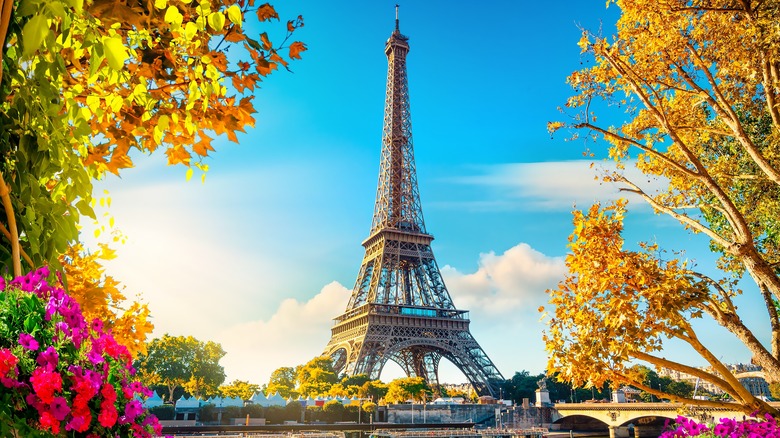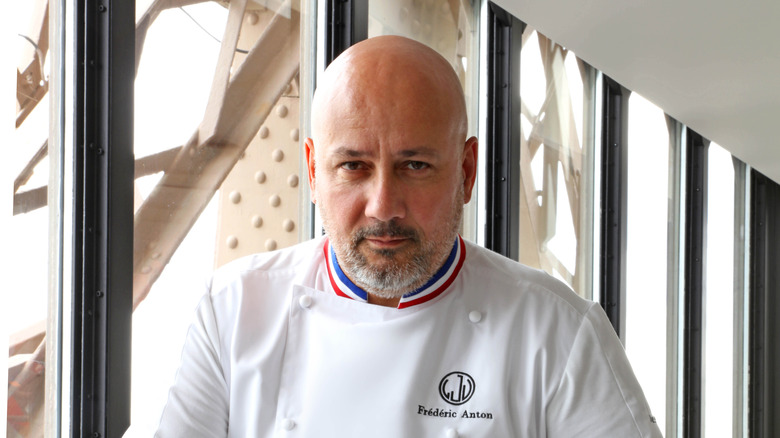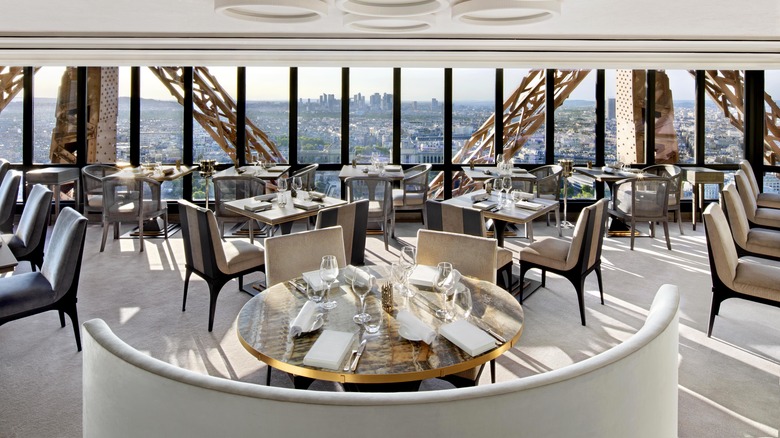The Michelin Star Restaurant You Can Visit In The Middle Of The Eiffel Tower
Whether marveling at the iconic shape as it towers over the city or admiring how it lights up the Parisian night, the Eiffel Tower has become a symbol of French culture and craftsmanship. It is only fitting, then, that within this iconic tower is a double Michelin-starred restaurant serving inspired French haute cuisine. Named after the famous French novelist and playwright, Le Jules Verne is a prestigious restaurant on the second floor of the iconic Eiffel Tower, 410 feet in the air. While there is no shortage of great food in the City of Love, including a must-see restaurant loved by Anthony Bourdain and Ina Garten's unpretentious Paris favorite, few can boast the historic locale and accolades of Le Jules Verne.
The restaurant received its first Michelin star in 2020, just five months after opening. And just four years later, a second star was awarded to Le Jules Verne; a first in the history of the Parisian monument. Though the restaurant was originally constructed in 1983, the reopening in 2019 marked a new chapter for Le Jules Verne. The menu features specially crafted dishes inspired by the Iron Lady herself. It's hard to imagine a more uniquely Parisian gastronomic experience than a Michelin-starred meal with a view of the historic city from the legendary landmark.
Meet the chef, Frédéric Anton
Chef Frédéric Anton began working for Le Pré Catelan in 1997, and was awarded two Michelin stars in 1999. He has since earned Michelin stars at all three of his restaurants, including Le Jules Verne, and the only Seine yacht cruise to boast a Michelin star, Don Juan II. In 2000, he was honored with the title Meilleur Ouvrier de France, a coveted distinction awarded to the finest craftsmen in France every three to four years. Earning his third Michelin star in 2007 solidified him as one of the premier modern culinary minds in French cuisine.
As the chef de cuisine of Le Jules Verne, Frédéric Anton has crafted a menu that showcases a delicate balance of flavors and aromas, intent on letting each ingredient shine through in the finished product. Le Crabe is a popular dish that features Granny Apple Zephir, a style of whipped fruit confection, seasoned with tarragon. Le Chocolat, for dessert, is a warm soufflé that includes cacao nib ice cream and a Gavrotte biscuit; a light, buttery, crêpe-style cookie. Chef Anton's goal is to serve dishes that exist in an artistic dialogue with the aesthetics and architecture of the Eiffel Tower, creating a sense of place through the one-of-a-kind dining experience.
A history of fine dining in the Eiffel Tower
From its initial opening to the public in 1889 for the Exposition Universelle, the Eiffel Tower has hosted many different restaurants. Originally, four dining pavilions occupied the first floor, each able to hold up to 500 people. These restaurants offered more than traditional Parisian fare, including Russian and Alsatian cuisine. All four restaurants were demolished in preparation for the 1937 International Exhibition, with only two ultimately being rebuilt.
The Eiffel Tower underwent renovations in the 1980s, and two new restaurants became the culinary heart of the now-famous landmark. The restaurants, La Belle France and Le Parisien, eventually merged to create one large, hot-air balloon-themed brasserie named Altitude 95 (highlighting the key difference between a French restaurant and a brasserie). Today, the establishment on the first floor is known as Madame Brasserie, serving contemporary French cuisine by chef Thierry Marx. And, of course, the multi-Michelin-starred Le Jules Verne sits hundreds of feet above on the tower's second floor. With a long legacy as a culinary destination and the recent awarding of a second star for Le Jules Verne, history continues to be made in the kitchens and dining rooms of the Eiffel Tower.



